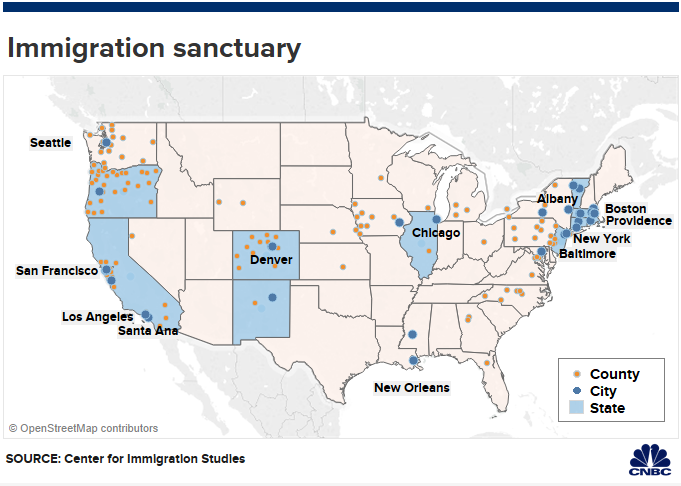Sanctuary cities could throw a wrench into President Donald Trump’s latest order to ramp up deportations of undocumented immigrants.
The president on Monday tweeted that his administration would be deporting millions of undocumented immigrants beginning next week, sparking fear in immigrant populations and their allies across the country. The president’s directive would represent a massive escalation of deportations.
The plan may run into roadblocks in locales that have implemented so-called sanctuary policies for immigrants, experts say, although such policies will not stop deportation efforts entirely.
Moreover, Immigration and Customs Enforcement’s resources are stretched thin, making the agency tasked with arresting migrants more reliant on local authorities in some areas. That too will hamper the administration’s ability to significantly increase its efforts.
Acting Director Mark Morgan said Wednesday that ICE will be sending agents into communities to detain and deport undocumented families as a deterrent to further migration, The New York Times reported. The agency has been preparing in recent days to conduct mass arrests, including pulling in assistance from Homeland Security investigative agents, according to the Times.
But seven states and close to 200 counties and cities have enacted sanctuary laws or policies, according to the Center for Immigration Studies, that could disrupt the administration’s efforts.
The policies limit local law enforcement’s cooperation with ICE agents and restrict ICE’s access to local resources.
Sanctuary policies can vary widely among municipalities. Measures include limiting cooperation with ICE detention requests, referred to as detainers, restricting information-sharing with the Department of Homeland Security, and preventing local law enforcement officers from being deputized as federal immigration officers.
They do not, however, prevent ICE from detaining and deporting immigrants, according to immigration law experts.

“It’s about limiting the use of state and local resources in federal immigration enforcement, not actually stopping federal immigration enforcement from happening,” said Ruthie Epstein, deputy director of immigration policy for the American Civil Liberties Union.
Over time, though, the policies have contributed to a decline in migrant detentions, according to Lena Graber, an attorney for the Immigrant Legal Resource Center.
Despite the Trump administration’s efforts, deportation numbers have not reached the record-high levels they did in 2012 under President Barack Obama when more localities were enforcing ICE detention requests, Graber said.
“That has a real impact on overall numbers of deportations,” she said.
ICE said detainers are important to the agency’s work.
“When law enforcement agencies fail to honor immigration detainers and release serious criminal offenders, it undermines ICE’s ability to protect public safety and carry out its mission,” an ICE spokesman said. “ICE is committed to maintaining and strengthening its relationships with local law enforcement.’
The agency pledged to continue its immigration enforcement operations.
“The border crisis doesn’t start and stop at the border, which is why ICE will continue to conduct interior enforcement without exemption for those who are in violation of federal immigration law,” the agency said in a statement. “This includes routine targeted enforcement operations, criminals, individuals subject to removal orders, and worksite enforcement.”
Trump has frequently expressed hostility toward sanctuary cities.
In 2017, he signed an executive order to cut some federal funding to them, which was later blocked by a district court judge. In April, he said he was considering releasing undocumented immigrants into sanctuary cities, although the Department of Homeland Security had rejected the plan twice in the past year.
Per Trump’s tweet this week, ICE will “begin the process of removing the millions of illegal aliens who have illicitly found their way into the United States … as fast as they come in.”
ICE likely lacks the resources to deport migrants on this scale, The Washington Post reported.
The agency averages 7,000 deportations per month. It deported 256,085 undocumented immigrants last year, according to ICE statistics.
ICE arrests are also down 7% from 2017, according to the Post, in part because hundreds of ICE agents have been sent to the U.S. border with Mexico to beef up security.
ICE leans on local governments to fill shortages in its own resources, meaning that sanctuary policies could also hamper mass deportation efforts, Graber said.
“Over the last few decades, the way that DHS has carried out most of its deportations is by co-opting the resources of local and state agencies,” she said. “Without the assistance and active help and participation of localities, DHS can’t deport as many people as they otherwise would.”
Once immigrants are detained, deporting them is not always a quick process.
They can be deported immediately only if they have a pending removal order, have been previously ordered deported or agree to voluntary deportation, Epstein and Graber said.
If not, they first have the opportunity to face an immigration judge to argue for the right to remain in the country, Epstein said.
Immigration courts are facing significant backlogs due to shortages of judges, according to Ashley Tabaddor, president of the National Association of Immigration Judges, further delaying the deportation process.
 EU News Digest Latest News & Updates
EU News Digest Latest News & Updates



